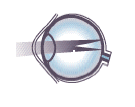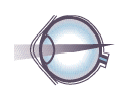Common refractive errors
It is important to understand your specific vision problem and how laser vision correction can be used to treat it. Your eye shape and cornea are keys to better vision. When light enters the eye it is bent, or refracted, by a clear tissue on the front of the eye called the cornea. The cornea, in effect, acts like a lens to focus incoming light onto the retina on the back of the eye.
Below are the most common eye problems that can be corrected with LASIK laser correction surgery:
Myopia, or nearsightedness

If you have myopia, or nearsightedness, it is because your eye shape is too long and/or you have an excessively steep cornea. As a result of this, light entering your eyes does not focus on the retina as it should, but instead focuses on images at a point in front of the retina. The result of nearsightedness is that your distant objects appear blurry, while near objects appear clear.
Hyperopia, or farsightedness

If you have hyperopia, or farsightedness, it is because either your eye shape is too short or you have an excessively flat cornea. In farsightedness, light entering your eye focuses on images at a point behind the retina. The result of farsightedness is that near objects you are seeing appear blurry, while distant objects appear clear. In some cases, hyperopia may cause blurriness at both distance and near
Astigmatism

If you have astigmatism it is because you have a cornea that is not spherical or basketball-shaped as is a normal eye, but your cornea is typically shaped more like a football. The result of astigmatism is that the objects you are viewing are not focused into a single image and vision is distorted or blurry. Astigmatism can be present alone or in addition to nearsightedness or farsightedness.
Remodeling the Cornea
If you are wearing glasses or contacts, these bend the light as needed to adjust for your eye prescription. In a laser vision correction procedure, Dr Sagar Bhargava will use an excimer laser to remodel the cornea to properly refract light for corrected vision. The laser pulses cool, invisible ultraviolet light to painlessly reshape the cornea in a precisely controlled manner without damaging adjacent eye tissue. The cornea then properly refracts light so you can see naturally. These lasers are the most advanced FDA approved equipment to assure you the most precise eye correction available.



 info@lasik-kolkata.com
info@lasik-kolkata.com